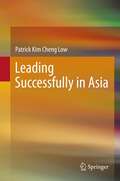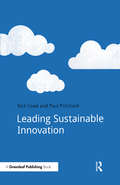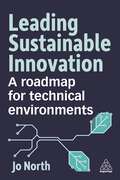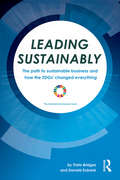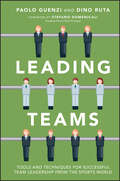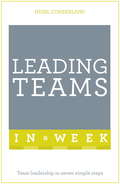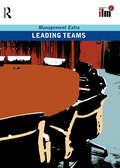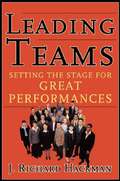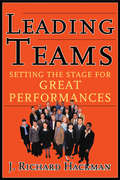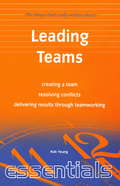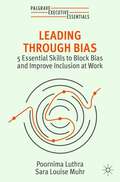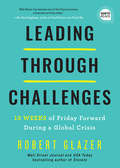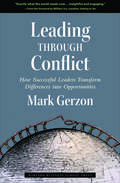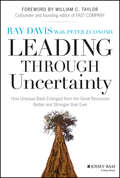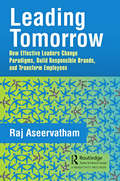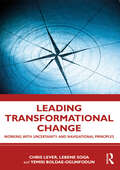- Table View
- List View
Leading Successfully in Asia
by Kim Cheng Patrick LowThe book captures the essence of leadership, its characteristics and ways in Asia through the cultural and philosophical visor. With Asian sayings, proverbs and quotes, the book discusses leadership issues and ways in the major Asian countries including China, India, Indonesia, Japan, Malaysia and Singapore. The leadership styles and ways of various great Asian national leaders and corporate leaders in these Asian countries are also examined. Perhaps of much interest to scholars and students of leadership, certain unique Asian features such as Buddhism, Confucianism, Ta Mo, Chinese Animal zodiac signs, Hindu Gods, the Samurai, the Spirit of Bushido and Zen are examined in the light of leadership mastery and excellence. The book is also intended to be a practical book that gives numerous examples of a potpourri of leadership skills and ways a person needs to be a leader. It is very action-orientated, the reader is urged to think about it, reflect and act.
Leading Successfully in Asia
by Patrick Kim LowThe book captures the essence of leadership, its characteristics and ways in Asia through the cultural and philosophical visor. With Asian sayings, proverbs and quotes, the book discusses leadership issues and ways in the major Asian countries including China, India, Indonesia, Japan, Malaysia and Singapore. The leadership styles and ways of various great Asian national leaders and corporate leaders in these Asian countries are also examined. Perhaps of much interest to scholars and students of leadership, certain unique Asian features such as Buddhism, Confucianism, Ta Mo, Chinese Animal zodiac signs, Hindu Gods, the Samurai, the Spirit of Bushido and Zen are examined in the light of leadership mastery and excellence. The book is also intended to be a practical book that gives numerous examples of a potpourri of leadership skills and ways a person needs to be a leader. It is very action-orientated, the reader is urged to think about it, reflect and act.
Leading Successfully in Asia
by Patrick Kim LowThe book captures the essence of leadership, its characteristics and ways in Asia through the cultural and philosophical visor. With Asian sayings, proverbs and quotes, the book discusses leadership issues and ways in the major Asian countries including China, India, Indonesia, Japan, Malaysia and Singapore. The leadership styles and ways of various great Asian national leaders and corporate leaders in these Asian countries are also examined. Perhaps of much interest to scholars and students of leadership, certain unique Asian features such as Buddhism, Confucianism, Ta Mo, Chinese Animal zodiac signs, Hindu Gods, the Samurai, the Spirit of Bushido and Zen are examined in the light of leadership mastery and excellence. The book is also intended to be a practical book that gives numerous examples of a potpourri of leadership skills and ways a person needs to be a leader. It is very action-orientated, the reader is urged to think about it, reflect and act.
Leading Sustainable Innovation
by Paul Pritchard Nick CoadSustainability will play an increasingly key role in the innovation process within businesses. Leading companies are already integrating these agendas, and preparing their sustainability executives to take the lead. This book demonstrates why sustainability requires innovation; explains how this opportunity can be grasped by sustainability executives; outlines the skills they will need to learn to lead on sustainable innovation; and outlines key trends in sustainable innovation and in managing innovation. Coad and Pritchard provide an overview of mainstream innovation, and draw out common characteristics of successful programmes, such as a corporate culture whose systems promote innovation. They highlight developments such as mobile technology, social media and collaborative consumption which transform the way consumers interact with companies. Viewed alongside emerging ideas on sustainability, such as the circular economy, this points to a clear need for a new set of innovation skills. Companies will face challenges in realizing these opportunities, in particular the development requirements for sustainability executives and broader organizational learning. This book is for companies who want to take advantage, and the sustainability executives who will be leading the way.
Leading Sustainable Innovation: A Roadmap for Technical Environments
by Dr Jo NorthLeading Sustainable Innovation shows how to deliver eco-innovation within technical environments. It is tailored to support innovation leaders and managers in fields such as transport, engineering, infrastructure, energy, utilities and sciences.This book offers practical methodologies, tools, frameworks and actionable steps that readers can implement to create lasting sustainable change for their projects and programs. Through following a step-by-step process, readers will craft a comprehensive roadmap for sustainable innovation, customized for any team or organization. It is aligned with the United Nations Sustainable Development Goals.Leading Sustainable Innovation examines multiple drivers of sustainable innovation, such as innovation strategies, state-of-the-art technologies, circular solutions and organizational factors necessary for success. It emphasizes distinguishing good ideas from weak ones and provides guidance on building a sustainable innovation culture. It features real-world, global examples and case studies such as the Microsoft Sustainable Datacenters (global), the Sellafield Nuclear Power Station Decommissioning (UK), Wunsiedel (Germany), Clean Path (New York), Roads and Transport Authority (Dubai) and Agriphotovoltaic Assets (China), enabling readers to learn valuable lessons from adjacent industries.
Leading Sustainably: The Path to Sustainable Business and How the SDGs Changed Everything
by Trista Bridges Donald EubankThe business world is at an important crossroads. The age of the stakeholder is rapidly superseding that of the shareholder as climate change and political and societal shifts upend years of seeming prosperity. To move past this agitated age, business and society must learn to lead sustainably by putting purpose on equal footing with profit. The first step is understanding what’s meant by sustainability and how it offers an opportunity for both business and society. Inspired by the launch of the 2030 United Nations Sustainable Development Goals (SDGs), the book captures the ideas of more than 100 change makers from around the world about how business is putting sustainability at the core of strategy to survive, thrive, and realign its interests with society’s. Leading Sustainably looks at how sustainability has evolved in a business context, offering powerful insights, key facts, and guidance on building sustainability capability within companies, measuring and managing impact, sustainable finance’s transformation, and other topics critical to aligning businesses’ central activities with sustainable principles. The book introduces five vignettes profiling best-in-class companies that were sustainable from the start and international case studies on business sustainability efforts, spanning industries from hospitality to waste management, fashion, finance, and more. Finally, Bridges and Eubank provide frameworks and in-depth direction firms can leverage when accelerating their transition to more sustainable business models. The book is a perfect guide for mid-level to senior managers seeking to understand this fast-changing business environment, how to factor sustainability into their decision-making, and why the SDGs changed everything.
Leading Teams
by Dino Ruta Paolo GuenziImportant new insights on team leadership and motivation, along with powerful tools and techniques taken from the world of sportsHow do the sports world's most successful coaches instill their teams with esprit de corps, a collaborative mindset, and an unbeatable desire to win? More importantly, what can business leaders and managers learn from their example? This book answers these and a host of key questions about what it takes to be a successful leader in business or in sports. Drawing upon their unique experiences working with top sports coaches, as well as some of the world's leading corporate executives, authors Dino Ruta and Paolo Guenzi offer important new insights into team leadership and motivation, as well as new tools for optimizing teamwork and inspiring teams to reach for and achieve new heights of glory.Develops a bold new team leadership model for managers at all levels, team leaders, project managers and facilitators, as well as sport coachesArms you with powerful tools and techniques adapted from the world of sport for optimizing teamwork, driving motivating and instilling an unstoppable desire to winAn indispensable source of insight and ideas for executives and managers in companies of all sizes, and an important supplement for postgraduate management programs
Leading Teams
by Harvard Business School PressLeading productive teams requires laying the groundwork for success and following through effectively. This guide offers immediately actionable advice on how to choose the right team members; clarify goals, rules, and responsibilities; foster trust, creativity, and risk taking; and resolve conflicts and maximize productivity.The Pocket Mentor Series offers immediate solutions to common challenges managers face on the job every day. Each book in the series is packed with handy tools, self-tests, and real life examples to help you identify your strengths and weaknesses and hone critical skills. Whether you're at your desk, in a meeting, or on the road, these portable guides enable you to tackle the daily demands of your work with greater speed, savvy, and effectiveness.
Leading Teams
by Jeffrey T. PolzerThis note which describes the architecture and processes that characterize effective teams, begins by detailing the steps involved in designing a team, from diagnosing the complexity, interdependence, and objectives of the task to harnessing the key resources teams need from their environment. It describes the qualities to search for when selecting team members, including finding the right number of people, individual skills along both technical and interpersonal dimensions, and a mix of skills appropriate for the task. Once the team is designed, team leaders and members need to shape and monitor team processes, starting with the team launch. Describes how to diagnose emergent team processes such as information exchange, collaboration, decision making, impression formation, and underlying identity dynamics. Includes steps managers can take to improve dysfunctional team processes such as restructuring and shaping the social forces within the team. Ends with a discussion of bridging differences in teams across both geographic and cultural divides.
Leading Teams In A Week: Team Leadership In Seven Simple Steps
by Nigel CumberlandLeading a team just got easierWe live in a world of teams made up of all kinds of people. We see this every day on TV, in newspapers and on the web - it might news about a winning sports team, a company's leadership team who have succeeded in buying another company or it might be a about a group of homeowners who have won a battle against a big developer. This book is aimed at helping all of us no matter what kinds of teams wemight need to lead - it might be a group of people running a country, playing a sport for university, organizing a Church fete, leading a start-up company, or managing a global multinational group. All such teams have leaders, who are those individuals given the task of ensuring that their team works well together to achieve whatever goals and objectives are required. Very few if any of us will spend our entire lives without at some point leading other people even if only for a short time and in many cases we often lead others without having a formal leadership title.In seven chapters, this book will walk you through the entire process of successfully leading and managing a team, showing you the key dos and don'ts and spelling out where you need to put special attention and focus. These seven chapters cover:- How to get started with a team, exploring what a great team looks like and how it performs, and how to create a new team from scratch with individuals who bring their own habits, skills and expectations- The stages of development of a team and how a new manager can gain the respect and understanding of a team - The importance of aligning a team and setting common goals and expectations with clear agreement on a mission, vision and values.- How to create a team culture and processes of excellent communication, with clearly understood expectations, well run team meetings and discussions, and the minimizing of any conflict and gossip- How to work with remote or virtual team members where face-to-face meetings are difficult to arrange- How to identify and work with problematic and nonperforming members of your team and how to balancefairness and discipline- How to ensure that each team member's job role is clear and that the work is efficiently delegated and shared among the team members- How to grow your team through excellent training and development, including coaching, mentoring and on-thejob training- How to turn a good team into a team with a culture of excellence- How to create a self-functioning team which can operate in your absence and in which you have groomed a successor to take over from you if needed.
Leading Teams In A Week: Team Leadership In Seven Simple Steps
by Nigel CumberlandLeading a team just got easierWe live in a world of teams made up of all kinds of people. We see this every day on TV, in newspapers and on the web - it might news about a winning sports team, a company's leadership team who have succeeded in buying another company or it might be a about a group of homeowners who have won a battle against a big developer. This book is aimed at helping all of us no matter what kinds of teams we might need to lead - it might be a group of people running a country, playing a sport for university, organizing a Church fete, leading a start-up company, or managing a global multinational group. All such teams have leaders, who are those individuals given the task of ensuring that their team works well together to achieve whatever goals and objectives are required. Very few if any of us will spend our entire lives without at some point leading other people even if only for a short time and in many cases we often lead others without having a formal leadership title.In seven chapters, this book will walk you through the entire process of successfully leading and managing a team, showing you the key dos and don'ts and spelling out where you need to put special attention and focus. These seven chapters cover:- How to get started with a team, exploring what a great team looks like and how it performs, and how to create a new team from scratch with individuals who bring their own habits, skills and expectations- The stages of development of a team and how a new manager can gain the respect and understanding of a team - The importance of aligning a team and setting common goals and expectations with clear agreement on a mission, vision and values.- How to create a team culture and processes of excellent communication, with clearly understood expectations, well run team meetings and discussions, and the minimizing of any conflict and gossip- How to work with remote or virtual team members where face-to-face meetings are difficult to arrange- How to identify and work with problematic and nonperforming members of your team and how to balancefairness and discipline- How to ensure that each team member's job role is clear and that the work is efficiently delegated and shared among the team members- How to grow your team through excellent training and development, including coaching, mentoring and on-thejob training- How to turn a good team into a team with a culture of excellence- How to create a self-functioning team which can operate in your absence and in which you have groomed a successor to take over from you if needed.
Leading Teams Revised Edition: Revised Edition (Management Extra Ser.)
by ElearnManagement Extra brings all the best management thinking together in one package. The series fuses key ideas with applied activities to help managers examine and improve how they work in practice. Management Extra is an exciting, new approach to management development. The books provide the basis for self-paced learning at level 4/5. The flexible learning structure allows busy participants to study at their own convenience, minimising time away from the job. The programme allows trainers to quickly plan and deliver high quality, business-led courses. Trainers can select materials to meet the needs of their delegates, clients, and budget. Each book is divided into themes of ideal length for delivering in a training session. Each theme has a range of activities for delegates to complete, putting the training into context and relating it to their own situation and business. The books’ lively style will stimulate further interest in the subjects covered. Guides for further reading and valuable web references provide a lead-in to further research. Management Extra is based on the NVQ framework to ease the creation of Diploma, Post Graduate Diploma or NVQ programmes for managers. It is accredited with all leading awarding bodies.
Leading Teams: Setting the Stage for Great Performances
by J. Richard HackmanHackman (social and organizational psychology, Harvard U. ) identifies the factors of being a team leader that will enable a team to work together efficiently to achieve organizational goals. He suggests that five conditions are necessary: having a real team, a compelling direction, an enabling team structure, a supportive organizational context, and expert team coaching. He integrates insights from interviews with team leaders with concepts from the social sciences.
Leading Teams: Setting the Stage for Great Performances
by J. Richard HackmanRichard Hackman, one of the world's leading experts on group and organizational behavior, argues that teams perform at their best when leaders create conditions that allow them to manage themselves effectively. Leading Teams is not about subscribing to a specific formula or leadership style, says Hackman. Rather, it is about applying a concise set of guiding principles to each unique group situation--and doing so in the leader's own idiosyncratic way. Based on extensive research and using compelling examples ranging from orchestras to airline cockpit crews, Leading Teams identifies five essential conditions--a stable team, a clear and engaging direction, an enabling team structure, a supportive organizational context, and the availability of competent coaching--that greatly enhance the likelihood of team success. The book offers a practical framework that leaders can use to muster personal skills and organizational resources to create and sustain the five key conditions and shows how those conditions can launch a team onto a trajectory of increasing effectiveness. Authoritative and astutely realistic, Leading Teams offers a new and provocative way of thinking about and leading work teams in any organizational setting.
Leading Teams: create a team, resolving conflicts, delivering results through teamworking
by Dr. Rob YeungWritten for all levels of people in businesses of all sizes, this guide provides techniques for transforming teamworking. It covers the key points about leading teams.
Leading The UK Vaccine Task Force
by Amy C. Edmondson Claudia PienicaThis case describes the first six months of the UK Vaccine Taskforce, under the leadership of Kate Bingham. With a career spent in the private sector as a biotech investor, Bingham's appointment within the government was considered unusual. The overarching brief given to her by the UK Prime Minister was simple: "Stop people from dying." At that time, however, no vaccine for human coronaviruses had ever been successfully developed, and the average time to take any new vaccine to market was over ten years. Furthermore, the UK had a relatively weak market position. Bingham assembled a senior leadership team of private sector experts and civil servants with the skills required to think about how to make vaccines, test them, deliver them, and build long-term resiliency into the system. Beyond building a diversified portfolio of vaccine candidates, the team took a commercial approach and aimed to make the UK the best global client possible. While there were some frictions due to the unusual setup of the taskforce, the team's work was an unequivocal success. The UK became the first country to approve and administer a COVID-19 vaccine outside of a clinical trial context, and had placed its bets on safe and effective vaccines.
Leading Things You Didn't Start: Winning Big When You Inherit People, Places, and Possibilities
by Tyler ReaginA high-impact leadership coach gives you the tools you need to maximize your influence in a new role, giving you the ability to meet any challenge and take your team, organization, church, or company to new heights.&“A practical path to maximizing your influence, navigating transitions, and producing positive results.&”—Jon Gordon, 10x bestselling author of The Power of Positive LeadershipSure, it&’s inspirational when we hear stories about those who founded companies from their garages with one hundred dollars cash while in high school. But such success is super rare and not always how it plays out for great leaders. The reality is that most leaders are responsible for corporations, teams, and products they didn&’t launch from the ground up. Tyler Reagin saw the immense need to address this mission-critical but often overlooked aspect of leadership: healthy transition for leaders who inherit teams, places, or platforms others created. His groundbreaking book Leading Things You Didn&’t Start provides a faith-based four-step plan that answers practical questions such as:• Do I really want to take over something loved by so many?• Is there a secret sauce to doing what the leaders before me did?• How do I get the current team on board with my leadership?• How do I honor the past without being trapped by it?• How do I steward the legacy of the leaders who started the movement?Through the use of tried-and-true coaching principles and practical case studies with leaders like Buzz Williams, head coach at Texas A&M, and Cheryl Bachelder, former CEO of Popeyes, Reagin helps you maximize your newfound influx of influence and master the intentions of an inheriting leader.
Leading Through Bias: 5 Essentials Skills to Block Bias and Improve Inclusion at Work (Palgrave Executive Essentials)
by Sara Louise Muhr Poornima LuthraBias is everywhere. While we cannot completely eliminate it, we can make efforts to become more aware of them, work hard to reduce them, and to minimise the impact they have on our organisations and the people who work within them.By identifying 7 essential skills – conviction, clarity, accountability, authenticity, allyship, strength, and vulnerability – the book offers an all-in-one resource to help you explore the topics of inclusive leadership and the role of leaders in addressing bias within a global context. Chapters are grounded in theoretical frameworks while mini-case studies and self-reflective exercises are presented throughout, making this ideal reading for anyone in a position of leadership, leadership development or those in DEI initiatives. Likewise, this is a comprehensive resource for executive students, particularly as it enables students to reflect on their individual and organisational journeys towards inclusion along with key features such as additional reading, a glossary of essential terms and practical take-aways and learning points.This is not a book about ‘fixing the minority’ or asking people to ‘lean in.’ This book is about addressing the structure, culture and practices through inclusive leadership – not just to achieve the outcome of a more diverse workforce, but also for leadership development; a leader who is more inclusive is also a better leader.
Leading Through Challenges: 13 Weeks of Friday Forward During Global Crisis (Ignite Reads)
by Robert GlazerFrom national bestselling author, Robert Glazer, Leading through Challenges: 13 Weeks of Friday Forward During Pandemics and Protest provides readers with 13-methods from his viral platform (of the same name) that will inspire, motivate, and create lasting change—week over week.These 13 specific passages were selected in promotion of the current events readers are experiencing leading up to the print release of Friday Forward. Hand selected from his February thru June 2020 Friday Forward notes to readers, this collection is sure to inspire you week over week through the unique challenges of our time.Look for the full length book, Friday Forward, coming Septemeber 2020! Available for preorder on Amazon now!When Robert decided to e-mail his team on Friday mornings a message for their personal growth, he had no idea what he was starting. The team loved them, and began to share outside of their company. Suddenly he had requests to send to leaders, and when the list became unmanageable, opted to create subscribers. Now, Friday Forward reaches over 100,000 readers across 50 countries. This collection of most read messages and new prompts are packaged as a weekly devotional for you to end your week stronger than you started it, and as it has from the start: creates a space for reflection, growth, and opportunity.
Leading Through Conflict
by Mark GerzonAs our world grows smaller, opportunities for conflict multiply. Ethnic, religious, political, and personal differences drive people apart-with potentially disastrous consequences-and it's the task of perceptive leaders to bring them together again World-renowned mediation expert Mark Gerzon argues that leaders have failed to rise to this challenge. Our organisations, schools, and governments remain filled with divisive dictators and everyday managers, instead of what he calls mediators-leaders who transform conflict so that everyone can move forward together. Through absorbing examples drawn from decades of work with organisational, political, and global conflicts of all kinds, Leading Through Conflict provides a powerful new framework for the leader as mediator, and outlines eight specific tools these leaders use to transform seemingly intractable differences into progress on deep-seated problems. Both practical and passionate, this book makes the tools of cross-border leaders accessible to anyone who wants to help create healthier companies, communities, and countries.
Leading Through Conflict
by Mark GerzonAs our world grows smaller, opportunities for conflict multiply. Ethnic, religious, political, and personal differences drive people apart-with potentially disastrous consequences-and it's the task of perceptive leaders to bring them together again World-renowned mediation expert Mark Gerzon argues that leaders have failed to rise to this challenge. Our organisations, schools, and governments remain filled with divisive dictators and everyday managers, instead of what he calls mediators-leaders who transform conflict so that everyone can move forward together. Through absorbing examples drawn from decades of work with organisational, political, and global conflicts of all kinds, Leading Through Conflict provides a powerful new framework for the leader as mediator, and outlines eight specific tools these leaders use to transform seemingly intractable differences into progress on deep-seated problems. Both practical and passionate, this book makes the tools of cross-border leaders accessible to anyone who wants to help create healthier companies, communities, and countries.
Leading Through Language
by Bart EgnalBecome a more effective leader--cut the jargon and say what you mean Leveraging. Strategizing. Opening the kimono. Unlocking human capital. Trying to nail that BHAG. All on a go forward basis. These are only a few examples of the jargon-ridden language that is too often the mainstay of business communication. Jargon frustrates, confuses, and generally alienates listeners. Yet it's also everywhere, and using it can often seem like a mandatory requirement for anyone who wants to establish credibility in a professional workplace. To be an effective leader, you must be brave enough to be the first to drop jargon in favor of simple, coherent language. This can be difficult if you've spent years immersed in business culture, but Leading Through Language will show just how much you've come to rely on jargon, why it's holding you back, and how to trim it away to more effectively convey information and ideas. Understand why jargon is reviled, yet ubiquitous Learn why "business speak" gets in the way of business Discover what kind of language influences and inspires others Convey ideas with clarity, energy, and conviction Approach all communication as an act of leadership Communication often falls by the wayside in favor of more measurable data-backed performance metrics; but good communication has the power to improve metrics in every area of an organization. Leading Through Language is the business world's much-needed guide to true leadership communication, showing you how to eliminate idle talk and master compelling communication.
Leading Through Uncertainty: How Umpqua Bank Emerged from the Great Recession Better and Stronger than Ever
by Raymond P. DavisFrom the CEO of Umpqua Bank, the essential leadership practices that allowed the West Coast’s largest independent community bank to emerge from the economic crisis even stronger than before In this follow-up to the successful Leading for Growth, Umpqua Bank CEO Ray Davis shares the tactics and strategies that have allowed Umpqua to grow and succeed in the toughest economic environment. The results are clear: despite years of economic uncertainty, Umpqua has continued its upward trajectory—expanding from five locations in 1994 to more than 200 today. Davis’s approach can help leaders recalibrate their approaches, no matter what the industry or market upheaval they face. In Leading Through Uncertainty, Davis shares a concise set of smart, actionable leadership practices that leaders can use to navigate their businesses and teams through difficult times. These include focusing on honesty and transparency, motivating and inspiring employees, building an outstanding corporate reputation, paying attention to details, and more. By showing leaders how to maintain a clear value proposition and strong leadership, Leading Through Uncertainty will help any company secure a lasting foothold in any economy.
Leading Tomorrow: How Effective Leaders Change Paradigms, Build Responsible Brands, and Transform Employees
by Raj AseervathamMaintaining good business leadership in a world of rapidly changing expectations levied by customers, investors, society, governments and employees is a challenge. These stakeholders are increasingly making choices about if or how they support businesses – through the purchase of their products and services, shareholdings and financing, regulatory approvals, and even experiences working for them – based on not just what a business does, but how it does it. We are seeing shifts in stakeholder sentiments that manifest in a greater expectation that businesses work with society in addressing society’s contemporary concerns. This greater good that businesses bring is rewarded by a greater brand awareness, connection and loyalty, which in turn provides businesses with an underlying strategic advantage over the competition with its customers, investors and other stakeholders. But this greater good cannot be faked with PR and bought media; in an increasingly connected world populated by an increasingly savvy millennial stakeholder base, authentic leadership and its ability to effect cultural shifts in the DNA of businesses is essential. Failure to do so will likely result in shorter and less successful tenures of Board members and C-suite leaders as this business trend spreads. This book looks at how the emerging generation of leaders must change paradigms and transform their employees to do more than just operate a business. It examines how to effect culture shifts that are necessary to innovate businesses so that they simultaneously meet market needs while meeting stakeholder expectations on concerns as varied as ethical business conduct, labor practices, climate change, responsible use of diminishing natural resources and contribution to socio-economic challenges in their market catchments. These are perspectives and skills that are still glossed over, by academic and professional institutions, as they develop the leaders of the future. Essentially, this book: • Articulates the strategic business case for doing good in a good business; the why, and where this trajectory is leading • Provides strategies to lead authentically on the array of issues that provide key stakeholders – customers, investors, governments and employees – with a greater reason to engage with and build loyalty to the business • Provides strategies to energize and spark innovation among his/her employees in an organization on these issues so that transformative power is harnessed.
Leading Transformational Change: Working with Uncertainty and Navigational Principles
by Yemisi Bolade-Ogunfodun Chris Lever Lebene Richmond SogaLeading Transformational Change: Working with Uncertainty and Navigational Principles offers an examination of how best to manage organisational change in tumultuous times. Using the metaphor of ‘navigating in uncertain waters’, the book is a unique and accessible introduction to the area of leading and managing change. Readers are equipped with tools such as practical exercises and opportunities to reflect, allowing them to assess and enact positive change. Stories and real-life examples from the sea offer lively ways to apply theory to practice. The authors examine why so often transformational change fails and how to break free of these negative patterns of behaviour. The chapters provide a deep understanding of navigational principles and step by step show how to apply this understanding to various contexts of change. Topics cover situational analysis, best managerial practice, planning, leading change, and unexpected events. Student learning is supported and reinforced with in-text reflections, discussion questions, and learning checks.

